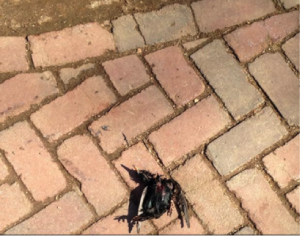Building strikes are the cause of 365-988 million bird mortalities annually in the United States (Loss et al.). Our BioGrounds group hopes to explore the prevalence of these mortalities in Charlottesville, Virginia and analyze the contributing factors. Finally, based on external research, we will suggest recommendations to lower the bird mortality rate and improve conditions for birds in Charlottesville.
We selected two buildings on the grounds of the University of Virginia to focus our efforts. Nau Hall and Campbell Hall were chosen based on the presence of large glass windows that reflect sunlight and give the appearance of a safe flight route. Additionally, the buildings are at a height that birds most commonly fly at, increasing the possibility for collision (San Francisco Planning Department 17). We plan to visit each building daily for two weeks. We will circle the perimeter of buildings, observe the buildings’ structures, and look for evidence of bird mortalities. These visits will be conducted in the mornings to maximize our chances of finding this supporting evidence because most mortalities occur at night due to low visibility during flight.
Additionally, we plan to schedule meetings with the Maintenance Directors of the buildings. These Maintenance Directors are highly familiar with the buildings’ structure and external conditions. We believe they may have stories or rough estimates of bird mortalities to share with us. We will ask if they have any further input to contribute to our findings. We also plan to get in contact with the Fatal Light Awareness Project (FLAP), in order to learn more about the group’s methods that will assist as we finalize our own methods in gathering data, as outlined above.
At the conclusion of our project, we will combine the quantitative data and qualitative observations from our visits to Nau and Campbell Halls, additional input from our discussions with the Building Maintenance Directors, and research into FLAP and other bird mortality prevention groups. We hope to offer solid recommendations for the University of Virginia and City of Charlottesville to proceed in improving conditions for the birds of Charlottesville.

Photo by Kaye Thomas

Photo by Kaye Thomas
Works Cited
Loss at al. Bird–building Collisions in the United States: Estimates of Annual Mortality and Species Vulnerability. The Condor: Ornithological Applications. January 2014.
San Francisco Planning Department. Standards for Bird-Safe Buildings. San Francisco, California: n.p., 2011. Print.
Post by Katherine Roderick, Susannah Saunders, Carolyn Albright, and Alison Lanshe